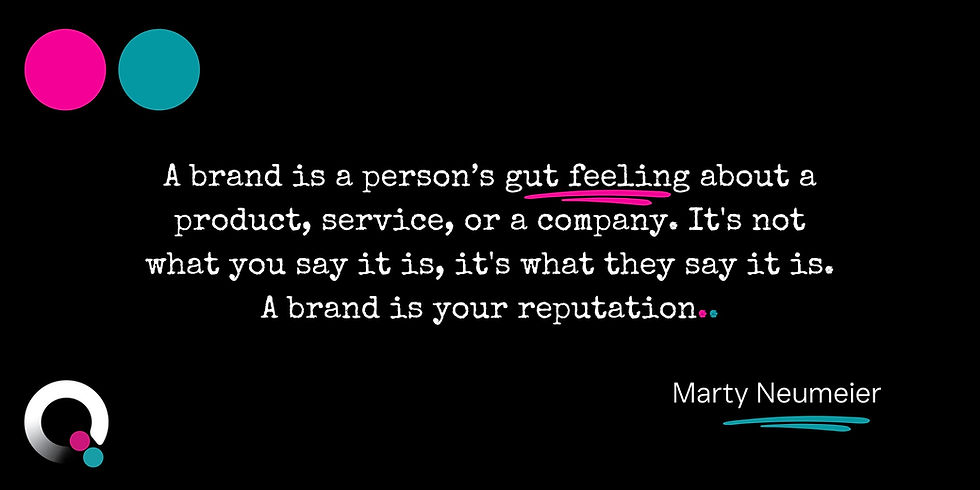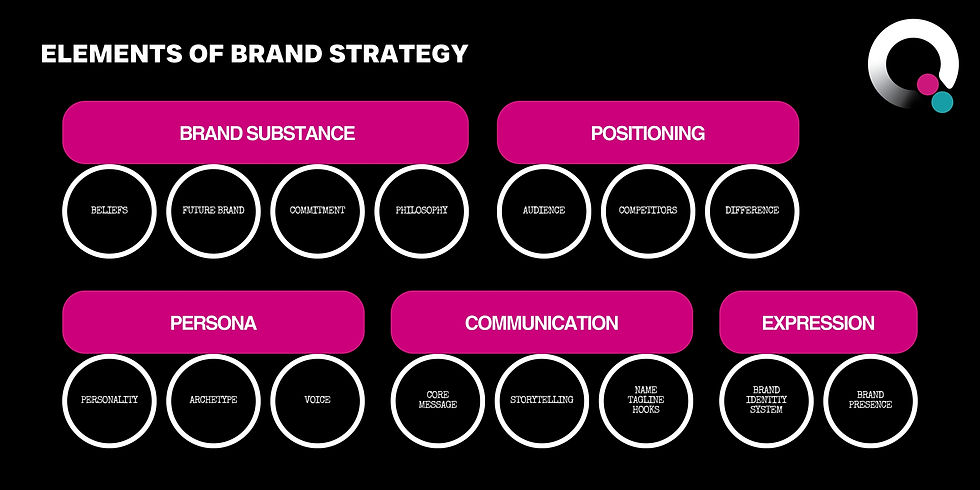Building an SME Brand: What is Brand and Brand Strategy?
- Matt Clutterham

- Mar 6, 2024
- 15 min read

In the last 25 years I have been a part of launching over 300 brands, but I'm always surprised that people still don't get what a brand actually is.
Welcome to the starting line, let's help you build your business with some real, honest talk about brands.
Forget the fancy jargon and fleeting trends; we're here to chat about what really makes a brand tick and how you can build one that connects with people, grows and also sticks around for the long-haul (because most fail)
In this short guide, we're breaking down the big ideas of brand and brand strategy into bite-sized, easy-to-get pieces. It's all about connecting the dots between who you are, what you stand for, and how you show up in your customers' lives.
We're not just talking logos or catchy slogans; we're diving into the heart and soul of both your business and your humans.
So, pull up a chair and let's explore how to create a brand that resonates, tells a story, and drives your business forward. This journey is about making your mark in a way that's genuine, bold, and totally you.
Let's build something that's not just seen but loved and remembered.
Ready to get started?
Let's dive in!

Understanding BRAND.
So, what's a brand, really?
Think of it as your business's personality. It's what people say about you when you're not in the room. Your brand is the vibe you give off, the feelings you stir up, and the memories you create in people's minds. It's not just about a cool logo or a slick website (though those things matter too); it's about how you make people feel.
A brand is like a promise you make to your customers.
It's the story you tell and the values you stand for. It's that gut feeling someone gets when they think about your business.
Do they trust you?
Are they excited by what you do?
Do they feel like you get them?
That's your brand at work.
Building a strong brand means knowing who you are and owning it.
It's about being clear on what you're all about and then shouting it from the rooftops (or, you know, sharing it on social media, your website, and anywhere else your customers hang out). It's the colors you choose, the words you use, and the way you treat your customers.
In short, your brand is your business's identity. It's what sets you apart from the crowd and sticks in people's minds long after they've left your website or walked out of your store.
And getting it right?
That's where the magic happens.

The Emotional Connect.
Let's get real about something..
At the end of the day, we're all human. And what do humans run on? Emotions.
That's right, feelings aren't just for movie nights and heart-to-hearts; they're the secret sauce in the world of branding.
Here's the deal..
People might forget what you said or did, but they'll never forget how you made them feel.
That's the emotional connect of your brand. It's not about the nuts and bolts of what you sell; it's about tapping into those vibes that make people feel something real.
Think about your favorite brands for a second..
What draws you to them?
Chances are, it's not just because they have great products. It's because they stir something in you.
Maybe it's a sense of adventure, a feeling of belonging, or the warm fuzzies of nostalgia. That emotional thread is what ties people to a brand, making them come back for more.
Creating that emotional connection means getting to the heart of your audience's desires, fears, dreams, and everything in between.
It's about showing up as more than just a business. You're a friend, a cheerleader, an advisor, all rolled into one.
So, when you're building your brand, think beyond the surface. Dive deep into the emotions you want to evoke. Whether it's making life easier, spreading joy, or inspiring action, your brand should touch the heart before it reaches the wallet. That's the kind of connection that lasts.
Brand Identity vs. Brand Image.
Alright, let's clear up some confusion. Brand identity and brand image might sound like the same thing, but they're actually two sides of the same coin. Getting to grips with these will help you steer your brand in the right direction.
Brand Identity
is all about you. It's the stuff you have control over—the look, the feel, the voice of your brand. Think of it as your brand's outfit and how it speaks. This includes your logo, color scheme, the way you write your website copy, and even how your store or office looks. It's what you put out into the world to say, "This is us, this is what we stand for."
Brand Image
On the other hand, is how people see you. It's the picture that forms in someone's mind based on their experiences with your brand, what they've heard about it, and how they feel about it.
You can influence this, sure, but you can't control it 100%. It's the result of how well your brand identity connects with people, meets their expectations, or surprises them in a good way.
Here's the deal..
You want your brand identity and brand image to match up as closely as possible.
When they do, it means people get you. They understand what you're about and what you're promising them. And when people get you, they're more likely to trust you, stick with you, and tell their friends about you.
When they don't.. when there is miss-alignmnet then there is mistrust, disappointment and a whole host of other things that means you've lost this relationship for good.
So, think of your brand identity as your game plan—how you decide to show up and play. Your brand image? That's your scoreboard—it shows how well you're doing in the eyes of your fans (aka your customers, your team, your investors.. every human that interacts with your business).
Keep your game strong, play fair, and that scoreboard will start to look pretty good.

The Essence of Brand Strategy.
Now, let's dive into the heart of the matter.. brand strategy.
Think of it as your brand's game plan for winning over the hearts and minds of humans.
It's not just about looking good or sounding catchy; it's about making smart, deliberate choices that guide how you communicate, who you're talking to, and ultimately, how your brand shows up in the world.
A solid brand strategy is like your business's North Star. It keeps you moving in the right direction, even when the market gets crowded or things get a bit chaotic. It's your roadmap for building a brand that not only stands out but stands the test of time.
Here's what goes into it:
Knowing Yourself
Before you can win over anyone else, you've got to know who you are. This is where you dig deep into your brand's soul. What's your purpose? What mission gets you out of bed in the morning? And that vision of yours—where's it taking you? Your origin story is gold, too; it's what sets you apart from the get-go.
Knowing Your Audience
You've got to get up close and personal with who you're trying to reach. What do they care about? What problems are they trying to solve? Understanding your audience is key to making sure your brand speaks their language.
The Competitive Landscape
Next up, scope out the scene. Who are you up against? What's the market like? Understanding your competitive landscape is like knowing the other players in a game. It helps you figure out where you fit in, what makes you different, and how you can stand out.
Your Unique Value Offering
What's your secret sauce? Your unique value offering (UVO) is that special something that nobody else can offer. It's the reason customers will choose you over the competition. Understanding and communicating your UVO clearly is crucial.
Defining Your Brand Personality
Just like people, brands have personalities. Are you the friendly neighborhood coffee shop, the adventurous outdoor gear brand, or the no-nonsense consultant? Your brand's personality should shine through in everything you do, from your website to your customer service. The more we can humanise your brand with personality the deeper connection it will have with people. (People buy from People not faceless entities)
Crafting Your Message
What's the big idea you want people to remember about your brand? This is your chance to tell your story in a way that connects, resonates, and sticks.
Choosing Your Channels
Not all platforms are created equal. Your brand strategy should pinpoint where your audience hangs out and how you can best reach them, whether it's through Instagram, email newsletters, or good old-fashioned billboards.
Being Consistent
Once you've set your course, stick to it. Consistency is what builds trust and familiarity. It's what makes your brand feel like an old friend.
In a nutshell, your brand strategy is your plan for how your brand is going to make some noise, get noticed, and win fans. It's about being intentional, being consistent, and always staying true to what you stand for.
Ready to make some waves? Let's do this..
Aligning Brand Strategy with Business Goals.
Let's talk about getting your ducks in a row. Your brand strategy shouldn't be off doing its own thing; it needs to be in step with your broader business goals. Think of your brand as a key player on your business team, one that's working towards the same wins as everyone else.
Start with the Big Picture
What's your business aiming for? Increased sales, entering new markets, or becoming a household name? Make sure your brand strategy is geared towards these goals.
Break It Down
Take those big goals and break them down into bite-sized, brand-related objectives. If you're aiming for market expansion, how can your brand reach and resonate with this new audience?
Tailor Your Message
Your brand's message should speak directly to your business goals. If innovation is your aim, your brand should scream innovation in every aspect, from your website design to how you talk on social media.
Customer Experience is Key
Every interaction a customer has with your brand should move you closer to your business goals. Great customer service isn't just nice to have; it's a strategic move that turns customers into brand advocates.
Measure What Matters
Keep track of how your brand activities are contributing to your business goals. Are you gaining more followers, getting more leads, seeing more engagement? These metrics should tie back to your overall objectives.
And don't hyperfocus on the actual numbers - FOCUS ON THE TRENDS of those numbers, this will give you a much better idea of how you are doing.
Stay Flexible
Business goals can shift, (The markets and consumer behaviour certainly will) and your brand strategy needs to be agile enough to shift with them. Regularly review your strategy to make sure it's still aligned with where your business is headed.
By keeping your brand strategy and business goals in lockstep, you're not just building a brand; you're building a brand that builds your business.
It's about making sure every part of your brand is pulling in the same direction as your company's ambitions. That's how you turn brand power into business success.

The Role of Audience Insight in Brand Strategy.
Getting to know your audience isn't just nice; it's essential.
It's like being a detective, piecing together clues to understand what makes your audience tick. This insight is gold when it comes to your brand strategy because it tells you how to talk to your audience, where to find them, and what they really want from you.
Digging Deep
Start with the basics—age, location, gender—but don't stop there. Dive into their hobbies, challenges, and dreams. What does a day in their life look like? What problems are they trying to solve?
Listening In
Social media, reviews, forums—these are your listening posts. Pay attention to the conversations happening around your brand and your industry. What are people excited about? What are they complaining about?
Asking Directly
Sometimes the best way to find out what someone wants is simply to ask. Surveys, feedback forms, and direct conversations can provide invaluable insights into your audience's mind.
Creating Personas
With all this information, create personas for your ideal customers. These aren't just fictional characters; they're detailed profiles that represent different segments of your audience. They help you visualise who you're talking to and tailor your message accordingly.
Applying Insights
Use these insights to inform every aspect of your brand strategy. From the tone of your messaging to the channels you choose for communication, understanding your audience ensures your brand resonates and connects on a deeper level.
Knowing your audience inside and out allows you to create a brand strategy that feels personal, relevant, and genuinely engaging. It's about building a connection that goes beyond transactions and turns customers into fans and advocates for your brand.
Brand Positioning and Differentiation.
Now that we're tight with our audience, it's time to talk positioning and differentiation. This is where you carve out your own special spot in the market and show what makes you different (and better) than the rest.
Finding Your Spot
Brand positioning is all about where you fit in the grand scheme of things. It's how you want your brand to be perceived in the minds of your customers. Are you the luxury choice, the budget-friendly option, or maybe the most innovative player in your field?
Standing Out
Differentiation is key. What's your unique selling point (USP)? This could be anything from your product's unique features, your unbeatable customer service, or even your company's values and social responsibility efforts.
Speaking Their Language
Use your audience insights to speak directly to your customers' needs and desires. Show them that you understand what they're looking for and that you're here to deliver just that.
Consistency is King
Keep your positioning and messaging consistent across all channels and touchpoints. Whether it's your website, social media, or in-store experience, make sure your brand's unique flavor comes through loud and clear.
Telling Your Story
Your brand's story is a powerful tool for differentiation. Share the 'why' behind your business, the challenges you've overcome, and what drives you. People connect with stories, and a compelling narrative can set you apart in a crowded market.
In a nutshell, brand positioning and differentiation are about finding your niche, owning it, and communicating it in a way that resonates with your audience. It's how you make sure your brand isn't just another face in the crowd but a beacon for those looking for exactly what you have to offer.

Consistency is Key.
Let's talk about consistency, the unsung hero of brand strategy. It's the glue that holds everything together and the secret sauce that makes your brand unforgettable. Consistency means your brand looks, feels, and sounds the same, whether someone's scrolling through your Instagram, browsing your website, or walking into your store.
Why Consistency Matters
When your brand is consistent, it builds trust. People know what to expect from you, and that familiarity breeds comfort. It's like visiting an old friend, no matter where you encounter them.
Visual Consistency
This includes your logo, colors, and fonts, ensuring they're used the same way every time. It's like wearing a signature outfit that makes you instantly recognizable in a crowd.
Tone of Voice
Whether it's playful, professional, or somewhere in between, your brand's voice should echo across all your content. It's about capturing your brand's personality in words and sticking to it.
Customer Experience
From the first click to the final purchase and beyond, the customer journey should feel seamless and in line with your brand values. It's the little things—how your team answers the phone, the tone of your emails, the vibe of your packaging—that all add up to a consistent brand experience.
Staying True to Your Core
Amidst all the noise and trends, it's crucial to stay true to your brand's core values and mission. That's the anchor that keeps your brand steady through the highs and lows.
In the world of branding, consistency isn't just about repetition; it's about creating a coherent identity that weaves through every aspect of your business. It's what turns a one-time buyer into a lifelong customer and transforms customers into brand advocates. Remember, in the journey of building a memorable brand, consistency is your best friend.
Future-Proofing Your Brand.
In a world that's always changing, how do you make sure your brand stays relevant? Future-proofing your brand means building a strategy that's not just successful today but can adapt and thrive over time. Here's how you can keep your brand strong, no matter what the future holds.
Stay True to Your Core
While trends and markets change, the core essence of your brand should remain constant. This is your brand's DNA—its purpose, values, and mission. Staying true to this core will keep your brand grounded and authentic.
Keep an Ear to the Ground
Being in tune with cultural, technological, and market trends is crucial. This doesn't mean chasing every new fad, but understanding how changes could impact your audience and your industry. Stay curious and be ready to adapt.
Foster a Community
Brands that build strong communities around their products or services create lasting connections. Engage with your audience, listen to their feedback, and make them feel like an integral part of your brand's journey.
Innovate Continuously
Innovation isn't just about new products; it's also about finding new ways to communicate, new experiences to offer, and new stories to tell. Keep exploring new ideas to keep your brand fresh and exciting.
Invest in Relationships
Building strong relationships with your customers, employees, and partners is key. These relationships can become your brand's most valuable asset, providing support and advocacy that drive long-term success.
Embrace Sustainability
More and more, consumers are looking for brands that care about the planet and their communities. Incorporating sustainability into your brand strategy can not only help the environment but also resonate with a growing segment of your audience.
Be Resilient
Finally, the ability to bounce back from challenges is what separates lasting brands from fleeting ones. Develop a resilient mindset within your organization, encouraging innovation and agility to navigate whatever comes your way.
Future-proofing your brand is about balancing what makes you unique with the ability to evolve. It's about being deeply connected to your purpose while staying open to change. With these strategies in place, you can ensure that your brand not only survives but thrives, no matter what the future holds.

Common Brand Strategy Questions Answered.
Embarking on a brand strategy journey often raises a lot of questions. Let's tackle some of the most common ones head-on, providing clear, straightforward answers to help demystify the process and set you on the right path.
How often should I revisit my brand strategy?
Think of your brand strategy as a living document. It's a good idea to review it at least once a year or whenever there's a significant change in your market, audience, or business goals. Staying flexible and adaptable is key.
Can a small business benefit from a brand strategy as much as a big one?
Absolutely! No matter the size of your business, a strong brand strategy helps you connect with your audience, stand out from competitors, and build customer loyalty. It's not about the size of your budget but the clarity of your vision.
I like to say.. If you can't out-spend them you've got to out-think them.
How do I know if my brand strategy is working?
Look for signs like increased brand recognition, customer engagement, and loyalty. Metrics such as website traffic, social media engagement, and sales figures can also provide tangible evidence of your strategy's impact.
Is it okay to change my brand strategy if it's not working?
Yes, it's essential to be flexible. If something isn't resonating with your audience or achieving the desired results, don't be afraid to pivot. The key is to make informed adjustments based on feedback and data.
How do I align my brand strategy with my overall business strategy?
Start by ensuring your brand values and mission complement your business goals. Your brand strategy should support and drive your business objectives, from product development to customer service and marketing efforts.
Can my brand strategy evolve over time?
Definitely. As your business grows and the market changes, your brand strategy should evolve too. The core of your brand might remain the same, but how you express it and engage with your audience can and should adapt over time.
Remember, brand strategy isn't set in stone; it's a guide that navigates your brand's growth and evolution. Being open to learning and adapting is part of what makes a brand strategy successful.
Conclusion.
Embarking on the journey of defining your brand and crafting a strategic vision for its future is more than a business exercise; it's a declaration of your place in the world and the impact you aspire to make.
We've looked at what a brand truly is, the pivotal role of brand strategy, and the practical steps to not only build but sustain a brand that resonates deeply with your audience.
Remember, your brand is the story that unfolds in the minds of your customers, shaped by every interaction they have with your business. It's built on the promises you make and the experiences you deliver. Whether it's through the distinct personality of your brand, the innovative solutions you offer, or the community you foster, every element plays a part in crafting a narrative that's compelling, authentic, and enduring.
In a world that's constantly evolving, the agility to adapt while holding true to your core values is what will set your brand apart. The future belongs to those who are bold enough to envision it, brave enough to pursue it, and committed enough to build it, one strategic step at a time.
If you need help with any of this then please Book a First Date with Us
A First date is the starting point for any great relationship (and ours should be no different!) Together we can build a strong foundation, a brand that is differentiated and stands-out, delivers a clear message and motivates humans to its mission and we can help you the people behind the brand with the clarity and confidence it takes to execute the BOLD future that your brand and humans deserve.
Find Out More..

Matt Clutterham
Co-Founder of Q Branch, Matt is a visionary in brand innovation and strategy, with an eye for transforming SMEs into market leaders. His expertise lies in creative branding for business growth, ensuring companies not only stand out but thrive. Matt is also a dynamic speaker, sharing thoughts on brand thinking and storytelling. Beyond the boardroom, he finds balance and inspiration in nature, and is an avid foodie!
If you enjoyed and found value in the free content I produce and want to say thanks - Why not Buy me a Coffee.





Comments